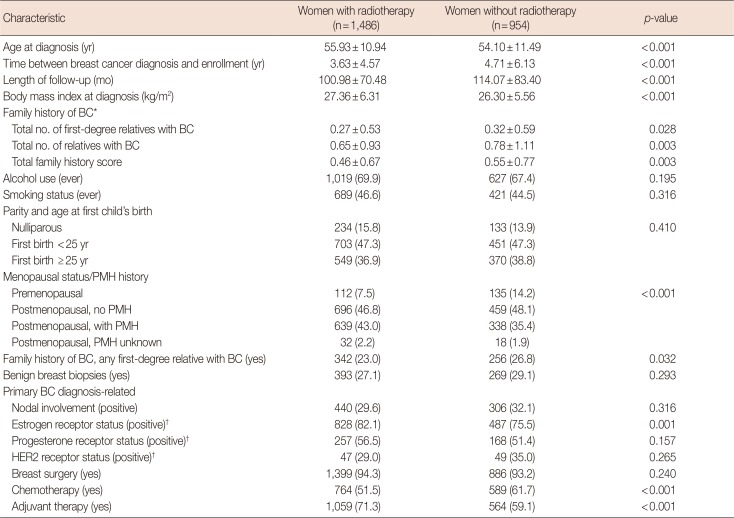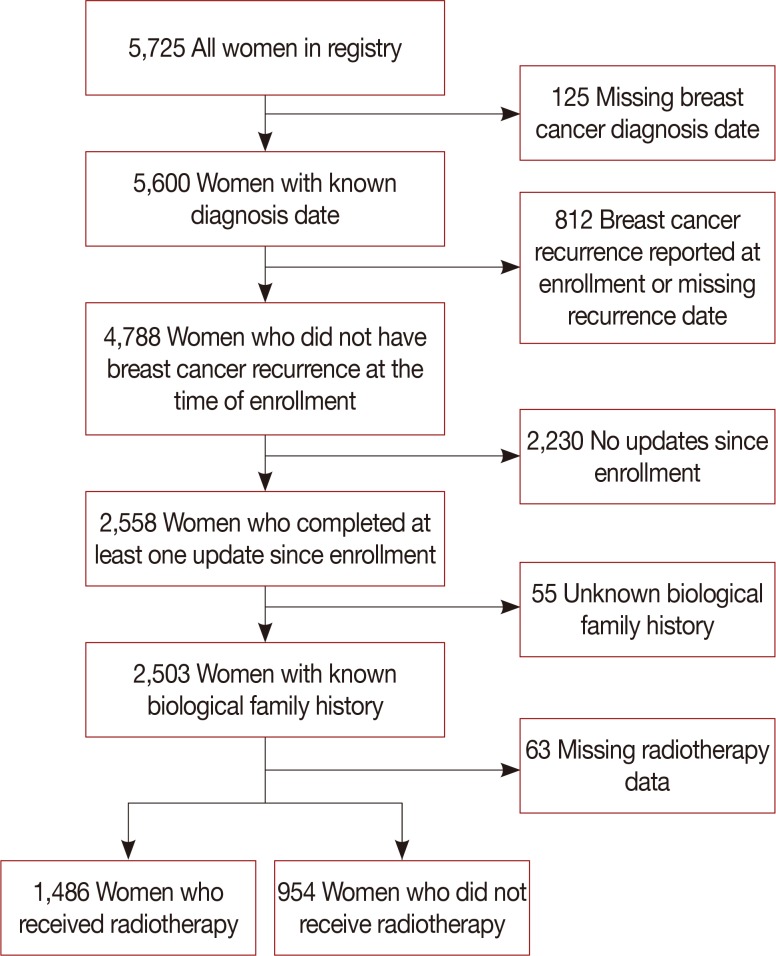1. Collaborative Group on Hormonal Factors in Breast Cancer. Familial breast cancer: collaborative reanalysis of individual data from 52 epidemiological studies including 58,209 women with breast cancer and 101,986 women without the disease. Lancet. 2001; 358:1389–1399. PMID:
11705483.
2. Fowble B, Hanlon A, Freedman G, Nicolaou N, Anderson P. Second cancers after conservative surgery and radiation for stages I-II breast cancer: identifying a subset of women at increased risk. Int J Radiat Oncol Biol Phys. 2001; 51:679–690. PMID:
11597809.

3. Reiner AS, John EM, Brooks JD, Lynch CF, Bernstein L, Mellemkjær L, et al. Risk of asynchronous contralateral breast cancer in noncarriers of BRCA1 and BRCA2 mutations with a family history of breast cancer: a report from the Women's Environmental Cancer and Radiation Epidemiology study. J Clin Oncol. 2013; 31:433–439. PMID:
23269995.

4. Bouchardy C, Benhamou S, Fioretta G, Verkooijen HM, Chappuis PO, Neyroud-Caspar I, et al. Risk of second breast cancer according to estrogen receptor status and family history. Breast Cancer Res Treat. 2011; 127:233–241. PMID:
20878464.

5. Drooger JC, Hooning MJ, Seynaeve CM, Baaijens MH, Obdeijn IM, Sleijfer S, et al. Diagnostic and therapeutic ionizing radiation and the risk of a first and second primary breast cancer, with special attention for BRCA1 and BRCA2 mutation carriers: a critical review of the literature. Cancer Treat Rev. 2015; 41:187–196. PMID:
25533736.

6. Hall MJ, Reid JE, Wenstrup RJ. Prevalence of BRCA1 and BRCA2 mutations in women with breast carcinoma In Situ and referred for genetic testing. Cancer Prev Res (Phila). 2010; 3:1579–1585. PMID:
21149333.

7. Donenberg T, Lunn J, Curling D, Turnquest T, Krill-Jackson E, Royer R, et al. A high prevalence of BRCA1 mutations among breast cancer patients from the Bahamas. Breast Cancer Res Treat. 2011; 125:591–596. PMID:
20838878.

8. Goode EL, Ulrich CM, Potter JD. Polymorphisms in DNA repair genes and associations with cancer risk. Cancer Epidemiol Biomarkers Prev. 2002; 11:1513–1530. PMID:
12496039.
9. Carmichael A, Sami AS, Dixon JM. Breast cancer risk among the survivors of atomic bomb and patients exposed to therapeutic ionising radiation. Eur J Surg Oncol. 2003; 29:475–479. PMID:
12798754.

10. Hill DA, Preston-Martin S, Ross RK, Bernstein L. Medical radiation, family history of cancer, and benign breast disease in relation to breast cancer risk in young women, USA. Cancer Causes Control. 2002; 13:711–718. PMID:
12420949.
11. Hiramatsu H, Bornstein BA, Recht A, Schnitt SJ, Baum JK, Connolly JL, et al. Local recurrence after conservative surgery and radiation therapy for ductal carcinoma in situ: possible importance of family history. Cancer J Sci Am. 1995; 1:55–61. PMID:
9166455.
12. Clarke M, Collins R, Darby S, Davies C, Elphinstone P, Evans V, et al. Effects of radiotherapy and of differences in the extent of surgery for early breast cancer on local recurrence and 15-year survival: an overview of the randomised trials. Lancet. 2005; 366:2087–2106. PMID:
16360786.
13. Vinh-Hung V, Verschraegen C. Breast-conserving surgery with or without radiotherapy: pooled-analysis for risks of ipsilateral breast tumor recurrence and mortality. J Natl Cancer Inst. 2004; 96:115–121. PMID:
14734701.

14. Hooning MJ, Aleman BM, Hauptmann M, Baaijens MH, Klijn JG, Noyon R, et al. Roles of radiotherapy and chemotherapy in the development of contralateral breast cancer. J Clin Oncol. 2008; 26:5561–5568. PMID:
18854572.

15. Stovall M, Smith SA, Langholz BM, Boice JD Jr, Shore RE, Andersson M, et al. Dose to the contralateral breast from radiotherapy and risk of second primary breast cancer in the WECARE study. Int J Radiat Oncol Biol Phys. 2008; 72:1021–1030. PMID:
18556141.

16. Gao X, Fisher SG, Emami B. Risk of second primary cancer in the contralateral breast in women treated for early-stage breast cancer: a population-based study. Int J Radiat Oncol Biol Phys. 2003; 56:1038–1045. PMID:
12829139.

17. Chabner E, Nixon A, Gelman R, Hetelekidis S, Recht A, Bornstein B, et al. Family history and treatment outcome in young women after breast-conserving surgery and radiation therapy for early-stage breast cancer. J Clin Oncol. 1998; 16:2045–2051. PMID:
9626202.

18. Harrold EV, Turner BC, Matloff ET, Pathare P, Beinfield M, McKhann C, et al. Local recurrence in the conservatively treated breast cancer patient: a correlation with age and family history. Cancer J Sci Am. 1998; 4:302–307. PMID:
9815294.
19. Kroenke CH, Chen WY, Rosner B, Holmes MD. Weight, weight gain, and survival after breast cancer diagnosis. J Clin Oncol. 2005; 23:1370–1378. PMID:
15684320.

20. Buist DS, Abraham LA, Barlow WE, Krishnaraj A, Holdridge RC, Sickles EA, et al. Diagnosis of second breast cancer events after initial diagnosis of early stage breast cancer. Breast Cancer Res Treat. 2010; 124:863–873. PMID:
20700648.

21. Figueiredo JC, Ennis M, Knight JA, McLaughlin JR, Hood N, O'Malley F, et al. Influence of young age at diagnosis and family history of breast or ovarian cancer on breast cancer outcomes in a population-based cohort study. Breast Cancer Res Treat. 2007; 105:69–80. PMID:
17115108.

22. Harris EE, Schultz DJ, Peters CA, Solin LJ. Relationship of family history and outcome after breast conservation therapy in women with ductal carcinoma in situ of the breast. Int J Radiat Oncol Biol Phys. 2000; 48:933–941. PMID:
11072148.

23. Jobsen JJ, Meerwaldt JH, van der. Family history in breast cancer is not a prognostic factor? Breast. 2000; 9:83–87. PMID:
14731704.

24. Turkoz FP, Solak M, Aksoy S, Petekkaya I, Keskin O, Kertmen N, et al. Association between family history and clinicopathologic characteristics in 1987 breast cancer patients: single institution experience from Turkey. J BUON. 2012; 17:649–657. PMID:
23335520.
25. Gierach GL, Ichikawa L, Kerlikowske K, Brinton LA, Farhat GN, Vacek PM, et al. Relationship between mammographic density and breast cancer death in the Breast Cancer Surveillance consortium. J Natl Cancer Inst. 2012; 104:1218–1227. PMID:
22911616.

26. Barisic A, Glendon G, Weerasooriya N, Andrulis IL, Knight JA. Accuracy of self-reported breast cancer information among women from the Ontario site of the breast cancer family registry. J Cancer Epidemiol. 2012; 2012:310804. PMID:
23316232.

27. Phillips KA, Milne RL, Buys S, Friedlander ML, Ward JH, McCredie MR, et al. Agreement between self-reported breast cancer treatment and medical records in a population-based Breast Cancer Family Registry. J Clin Oncol. 2005; 23:4679–4686. PMID:
15851764.

28. Li CI, Malone KE, Daling JR. Differences in breast cancer hormone receptor status and histology by race and ethnicity among women 50 years of age and older. Cancer Epidemiol Biomarkers Prev. 2002; 11:601–607. PMID:
12101106.
29. Broeks A, Braaf LM, Huseinovic A, Nooijen A, Urbanus J, Hogervorst FB, et al. Identification of women with an increased risk of developing radiation-induced breast cancer: a case only study. Breast Cancer Res. 2007; 9:R26. PMID:
17428320.

30. John EM, Phipps AI, Knight JA, Milne RL, Dite GS, Hopper JL, et al. Medical radiation exposure and breast cancer risk: findings from the Breast Cancer Family Registry. Int J Cancer. 2007; 121:386–394. PMID:
17372900.







 PDF
PDF ePub
ePub Citation
Citation Print
Print



 XML Download
XML Download